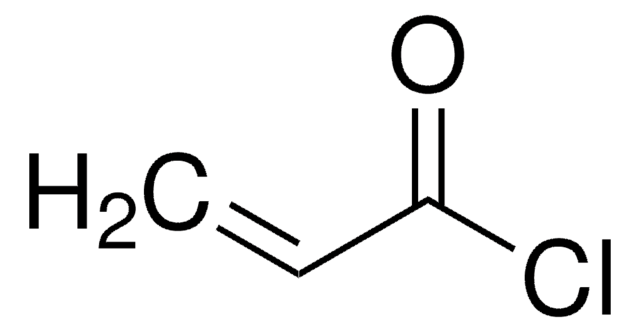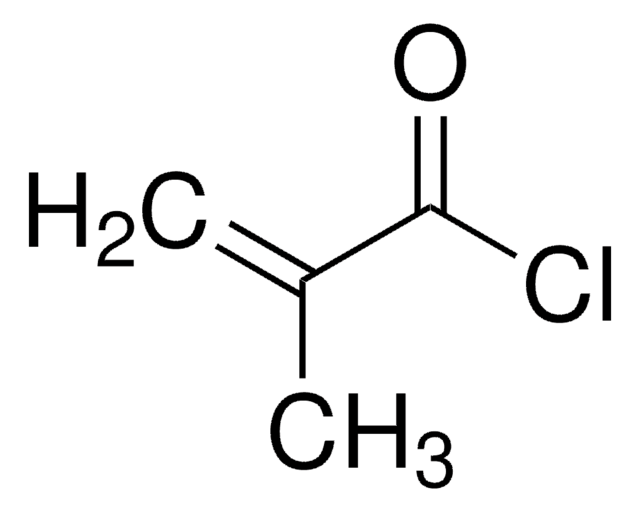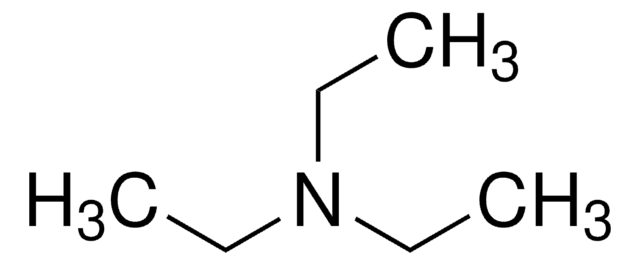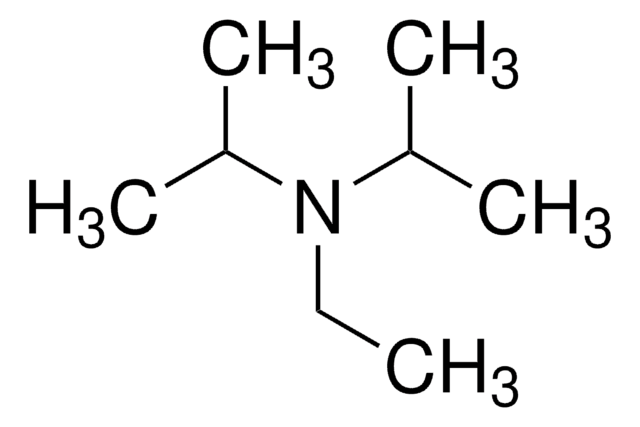549797
Acryloyl chloride
97.0%, contains <210 ppm MEHQ as stabilizer
Synonym(s):
2-Propenoyl chloride
Sign Into View Organizational & Contract Pricing
All Photos(3)
About This Item
Linear Formula:
CH2=CHCOCl
CAS Number:
Molecular Weight:
90.51
Beilstein:
635744
EC Number:
MDL number:
UNSPSC Code:
12162002
PubChem Substance ID:
NACRES:
NA.23
Recommended Products
vapor density
>1 (vs air)
Quality Level
vapor pressure
1.93 psi ( 20 °C)
Assay
97.0%
contains
<210 ppm MEHQ as stabilizer
refractive index
n20/D 1.435 (lit.)
bp
72-76 °C (lit.)
density
1.114 g/mL at 25 °C (lit.)
storage temp.
2-8°C
SMILES string
ClC(=O)C=C
InChI
1S/C3H3ClO/c1-2-3(4)5/h2H,1H2
InChI key
HFBMWMNUJJDEQZ-UHFFFAOYSA-N
Looking for similar products? Visit Product Comparison Guide
Related Categories
General description
Acryloyl chloride is a derivative of acrylic acid and is widely used as a reactive monomer in the synthesis of various polymers with desired properties such as good transparency, flexibility, excellent mechanical and thermal properties, and resistance to moisture and chemicals. Acryloyl chloride contains both an acryloyl group (-CH2=CHC(O)Cl) and a chloride functional group (-Cl) in its structure. This combination of functional groups enables acryloyl chloride to undergo polymerization reactions and participate in copolymerization processes. In the field of polymers, acryloyl chloride is commonly used in the production of acrylic polymers, such as polyacrylates and polymethacrylates. These polymers have a wide range of applications, including coatings, adhesives, sealants, textiles, and biomedical materials.
Application
Acryloyl chloride can used as a monomer in the synthesis of:
- Acrylic polymers via radical polymerization or copolymerization. These acrylic polymers can be tailored to possess the desired properties for biomedical coatings, including biocompatibility, adhesion to the device surface, and durability.
- Poly(styrene-co-acryloyl chloride) copolymer by crosslinked networks with styrene. The resulting crosslinked polymer can then be functionalized or modified by various chemical reactions to introduce specific properties or functionalities desired for the application as a polymer support or an electrophilic scavenger resin.
- Acrylamide-modified chitosan.
- Ulvan acrylate macromer via esterification of hydroxyl groups of polysaccharides. This macromer can be used to prepare ulvan-based thermosensitive hydrogels.
- Degradable peptide cross-linker by the acrylation of the amine groups of lysine residues and glutamine within peptide sequences.
Signal Word
Danger
Hazard Statements
Precautionary Statements
Hazard Classifications
Acute Tox. 1 Inhalation - Acute Tox. 4 Oral - Eye Dam. 1 - Flam. Liq. 2 - Met. Corr. 1 - Skin Corr. 1A
Supplementary Hazards
Storage Class Code
3 - Flammable liquids
WGK
WGK 3
Flash Point(F)
30.2 °F
Flash Point(C)
-1 °C
Regulatory Information
非剧毒-急性毒性1
Choose from one of the most recent versions:
Already Own This Product?
Find documentation for the products that you have recently purchased in the Document Library.
Andrea Morelli et al.
Carbohydrate polymers, 136, 1108-1117 (2015-11-18)
The present study is focused on the exploitation and conversion of sulphated polysaccharides obtained from waste algal biomass into high value added material for biomedical applications. ulvan, a sulphated polysaccharide extracted from green seaweeds belonging to Ulva sp. was selected
Soyeon Kim et al.
Biomacromolecules, 4(5), 1214-1223 (2003-09-10)
Hydrogels composed of N-isopropylacrylamide (NIPAAm) and acrylic acid (AAc) were prepared by redox polymerization with peptide cross-linkers to create an artificial extracellular matrix (ECM) amenable for testing hypotheses regarding cell proliferation and migration in three dimensions. Peptide degradable cross-linkers were
Iris Ben-David et al.
Applied radiation and isotopes : including data, instrumentation and methods for use in agriculture, industry and medicine, 58(2), 209-217 (2003-02-08)
An automated procedure for the radiosynthesis of the labeling synthon [11C]acryloyl chloride was developed and applied for labeling several N-acryl amides with carbon-11. [11C]-6-acrylamido-4-(3,4-dichloro-6-fluoroanilino)quinazoline (ML03), a novel PET biomarker targeting the epidermal growth factor receptor tyrosine kinase (EGFr-TK) in cancer
Thomas N Chiesl et al.
Analytical chemistry, 77(3), 772-779 (2005-02-01)
We have created a family of water-soluble block copolymers of acrylamide and N-alkylacrylamides that are designed to selectively remove proteins from DNA via microchannel electrophoresis. It was hypothesized that the inclusion of hydrophobic subunits in the polymer chain, in sufficient
Jung Im Lee et al.
International journal of pharmaceutics, 373(1-2), 93-99 (2009-05-12)
Chitosan/Pluronic hydrogels were prepared to develop injectable depot systems for gene therapy to enhance local transgene expression at injection sites. Water-soluble chitosan and Pluronic were separately acrylated to prepare photo-crosslinkable polymers. A mixture of acrylated polymers was mixed with plasmid
Our team of scientists has experience in all areas of research including Life Science, Material Science, Chemical Synthesis, Chromatography, Analytical and many others.
Contact Technical Service










